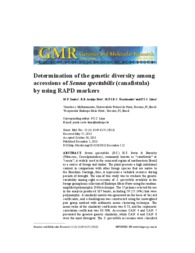Determination of the genetic diversity among accessions of Senna spectabilis (canafístula) by using RAPD markers.
Determination of the genetic diversity among accessions of Senna spectabilis (canafístula) by using RAPD markers.
Author(s): SANTOS, M. F.; ARAUJO NETO, R. B.; NASCIMENTO, M. P. S. B. C.; LIMA, P. S. C.
Summary: Senna spectabilis (DC.) H.S. Irwin & Barneby (Fabaceae; Caesalpinioideae), commonly known as ?canafístula? or ?cassia?, is widely used in the semi-arid region of northeastern Brazil as a source of forage and timber. The plant presents a high nutritional content in comparison with other forage species that are native to the Brazilian Caatinga; thus, it represents a valuable resource during periods of drought. The aim of this study was to evaluate the genetic variability among eight accessions of S. spectabilis available in the forage germplasm collection of Embrapa Meio-Norte using the random-amplified polymorphic DNA technique.
Publication year: 2013
Types of publication: Journal article
Unit: Embrapa Mid-North
Observation
Some of Embrapa's publications are published as ePub files. To read them, use or download one of the following free software options to your computer or mobile device. Android: Google Play Books; IOS: iBooks; Windows and Linux: Calibre.
Access other publications
Access the Agricultural Research Database (BDPA) to consult Embrapa's full library collection and records.
Visit Embrapa Bookstore to purchase books and other publications sold by Embrapa.

